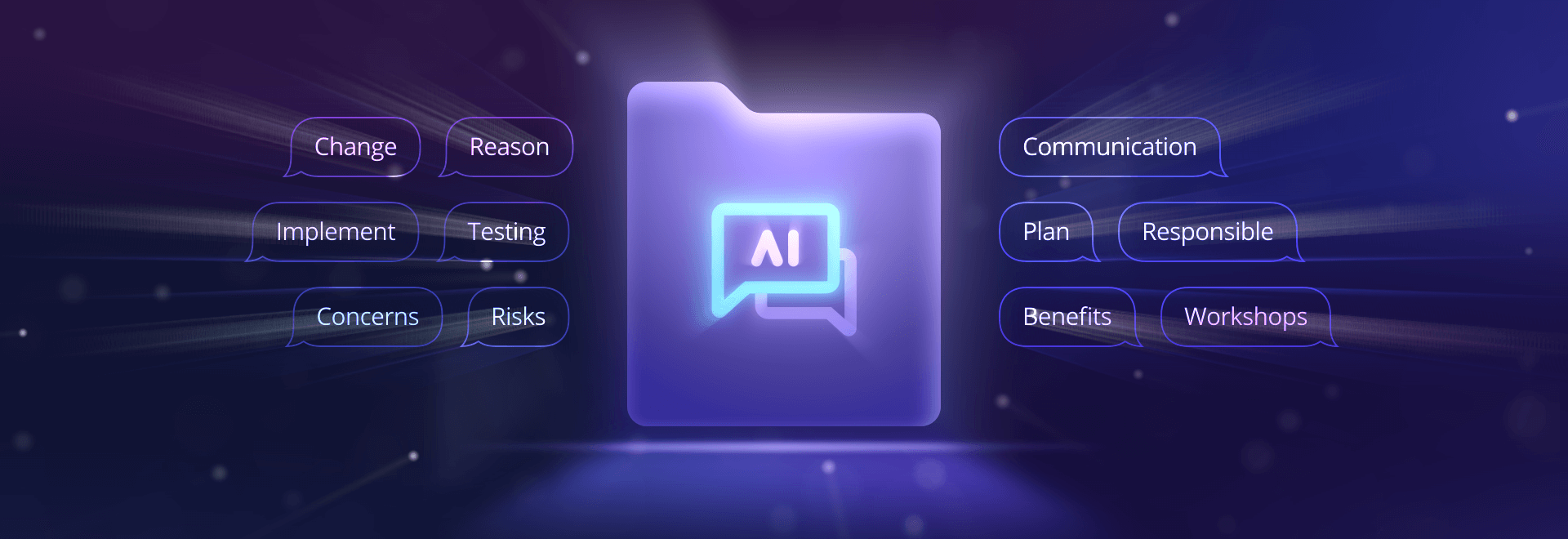AI & Change Management: How to Successfully Introduce a Chatbot to Your Company
Table of contents
So, you’re going to implement a chatbot. The virtual assistant will be instrumental in changing the way you interact with clients. But to be effective, it still must be accepted by your entire staff while also fulfilling precise strategic and commercial objectives. To make that happen, it’s no secret that you’ll need to guide and support your teams throughout the implementation process. You’ll need to get them onboard to cooperate and get the chatbot done. In this post, we want to show you how you can successfully implement a chatbot in your company.
You should treat developing a chatbot as a typical transformational project. It’s a type of project that:
- Involves multiple stakeholders
- Affects multiple different teams across the organisation
- Changes company’s workflow and everyday processes
In short – it alters the way your organisation works. Such a project becomes a vital part of your company’s life.

Implementing chatbots in your organisation is not like replacing an old printer with a new one. It is a transformation that is implemented across teams, processes, and workflows.
The only way to implement such a project successfully is by adopting the change management approach.
What is Organisational Change Management?
Put shortly, change management is a systemic approach or a discipline enabling your company to go through a specific transition (change) as smoothly as possible. As a valid part of change management, leadership should support internal teams and their stakeholders in everything that’s related to the current change (e.g., implementing a chatbot and the digital transformation that comes with it).
There are four major principles of IT change management:
- Understand change (Why do we need a chatbot? What should it do? What will change once this new bot is here?)
- Plan Change (How can we prepare for the “bot’s arrival”? What processes and activities must be adjusted to this new virtual assistant?)
- Implement Change (How should we implement this new bot? Where should it work? What kind of data does it need?)
- Communicate Change (Who should be informed about this new bot? Which channels should we use to communicate the fact that our company has a chatbot?)
Apart from that, you should also concentrate on change evaluation. This means assessing the results of the bot implementation. Set some KPIs and verify whether your chatbot achieves them (and why if not). Change evaluation is also about gathering feedback from users and stakeholders. Run some tests with your company’s employees – encourage them to test the chatbot and share their findings and opinions. Explain that such tests enable your company to identify areas for improvement and fix potential errors.
Change control is also important. Every time your chatbot is updated or modified, make sure you keep all the relevant documentation in one place. After each modification, your bot should be tested and reviewed once again. That’s the best way of minimising potential risks and addressing any unexpected issues or incidents ASAP.
7Rs of IT Change Management
Communication is especially crucial when it comes to IT change management. After all, you want your entire team on board, right? Therefore, you must make sure that everyone understands the need for this change and agrees with it. This is where the so-called 7Rs of change management come in handy. Follow this framework to ensure a smooth chatbot adoption in your company and create a clear communication plan.
- Who RAISED the change? For starters, you must ensure that the chatbot is compliant with the company’s goals and ambitions to automate repetitive/mundane tasks; that it will free up the time of employees so that they can focus on more creative and complex processes. The decision comes from the top and has full support across the leadership team.
- What is the REASON for the change? Explains the reasons behind your decision. These reasons can refer to the dynamic growth of AI, to the fact that customers simply want 24/7 customer service and that you want your company to be innovative and not overtaken by other, more tech-aware competitors.
- What is the RETURN required from the change? The best way to answer this question is by showing market data and case studies showing that a chatbot can significantly improve your company’s operations and lower the waiting time on a helpline.
- What are the RISKS involved in the change? Of course, there are always some risks involved. That’s why it’s important to explain that chatbot development is an ongoing process, and that all potential errors and glitches are continually monitored so that they can be eliminated as quickly as possible.
- What RESOURCES are required to deliver the change? Communicate the creation of the “chatbot taskforce” in your company – a team comprising key stakeholders involved in chatbot implementation. The product owner should be the person who’s responsible for the channel where your chatbot will be hosted (on your website, as a part of the call centre software, or on social media). You’ll most likely need to involve the customer service head, IT team, DevOps team, and design team. Additionally, work with your marketing manager to promote the new chatbot using both internal and external communication channels. Also, consider other resources that will be needed, especially a bot-building platform and its costs.
- Who is RESPONSIBLE for the design, testing, and implementation of the change? Ensure there is a project lead or a project manager who oversees the change. Perhaps it is a good time to promote someone from the innovation or IT team, assign other roles (mentioned above) to other task force members, and ensure a regular cadence of status meetings and company-wide updates on the status of the chatbot. The goal is for the rest of the company not to be surprised once the chatbot is launched.
- What is the RELATIONSHIP between this change and other changes? Perhaps your company has just gone through digital transformation, and people still aren’t fully used to the new working conditions. And now, there is a whole new change! Your goal is to get employees and shareholders comfortable with the change. Plus, you should explain that this is not the last AI project that will be implemented. Explain it’s part of the bigger AI transformation that doesn’t exist in a vacuum and constitutes an inherent part of your company’s development.
Tips on Creating an Internal Communication Plan
As we mentioned above, it’s a good idea to create an internal communication plan. Such a plan should comprise:
- The list of stakeholders that should get regular updates
- All the relevant communication channels (intranet, email, Slack, blog, newsletter, etc.)
- Support from the PR & Comms team to proofread all the bot-related materials
- Ideas to include employees in the implementation of the chatbot. For instance, you could organise a company-wide contest for the best chatbot name.
You WANT your whole company on board, especially if they are concerned about the new virtual assistant. Here are a few ideas on how you can get everyone in your company on board with this new chatbot. In fact, these suggestions work with any IT change management processes, so feel free to follow them in many different situations.
Clearly communicate the benefits and address concerns
Explain how the chatbot will improve your company’s efficiency, streamline everyday processes, and enhance customer service. Highlight that a chatbot is not here to take away people’s jobs but rather – to support them in their everyday work and free up their time for more strategic tasks. Understanding the benefits is clear to winning your team’s approval.
Training and workshops
Offer training sessions and workshops to educate employees about the chatbot’s capabilities, functionality, and how to use it. Make sure employees understand how the chatbot can support their daily tasks and address their concerns or questions. Make those training sessions engaging and fun. For example, you can show how the chatbot reacts to weird or funny questions, such as “I don’t feel like working today; what should I do?” The chatbot could respond by saying, “Me, too! You at least go home at 5 pm; I’m here all day long!” A little humour will help people feel comfortable with the bot.
Continually gather feedback
Getting feedback about the chatbot is important not just at the beginning but all the time. We encourage you to establish a feedback mechanism that will help your company gather ongoing feedback from employees regarding their experience with the chatbot. Regularly assess its performance, gather suggestions for improvement, and incorporate employee feedback into future updates or enhancements. This will also give your employees the vital feeling that they have an influence on the way your chatbot works.
Risks of Not Introducing the Chatbot Correctly
If you skip everything we mentioned above and just introduce the chatbot overnight, you must be prepared to deal with some serious problems. In fact, some employees can openly jeopardise this project and refuse to work with the chatbot.
If your company is not prepared for the chatbot, implementing it will take more time and will be more problematic. You may struggle with your team’s reluctance to help you build and promote the bot. All in all, without proper buy-in and motivation, your chatbot project may fail, meaning you’ve lost time and money investing in an unsuccessful project.
Thankfully, all that can be easily avoided – you just need to take some time to get your team on board and concentrate on the benefits this new virtual assistant will bring to the company. That’s what change management strategy is all about!
Now that you know how to win your team over, learn how to successfully introduce your new bot to your audience and gain high engagement.
Develop Your Chatbot with SentiOne
Are you thinking about implementing an AI chatbot? See how SentiOne Automate can help you – read more about our customer service automation platform and try out our ROI calculator to see how much you’ll save with a chatbot/voice bot. And when you’re ready – start with a free demo!
Article Summary
Implementing a chatbot requires strategic change management to ensure smooth adoption across teams and processes. Learn the principles of change management, including understanding, planning, implementing, and communicating change. Follow the 7Rs framework for clear communication and involve employees through training and feedback. Proper implementation prevents project failure and maximises the benefits of the new virtual assistant.



